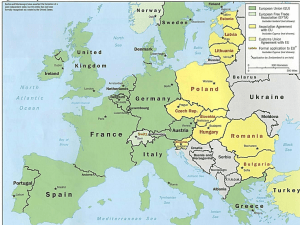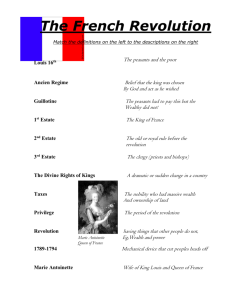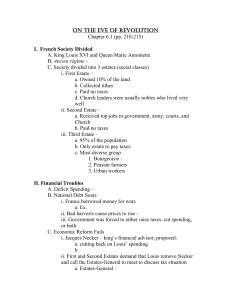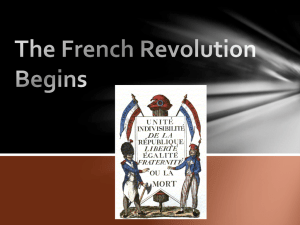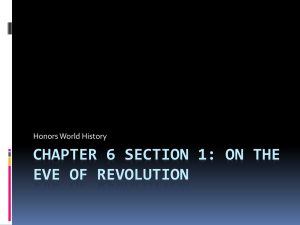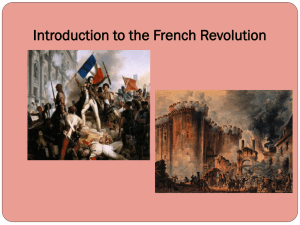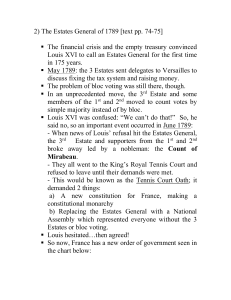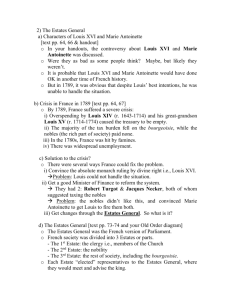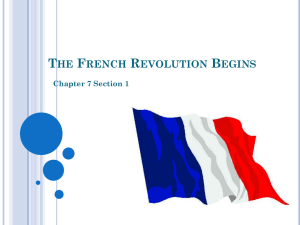Revolution Threatens the French King
advertisement
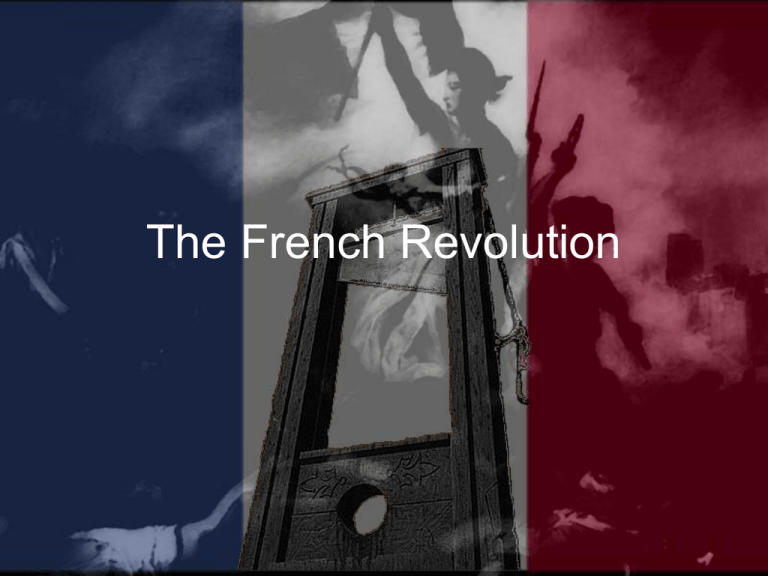
The French Revolution It’s the 1770’s in France • At this time, France’s citizens are divided up into three different estates • First Estate • This was the clergy of the Roman Catholic Church. • They made up less than 1% of the population, but owned 10% of the land and paid about 2% of their income to the state. • Second Estate • This was the nobles. • 2% of the population, but owned 20% of the land. Oh, and they didn’t pay taxes. • Third Estate • The other 98% of the population. • They too were divided into three different groups. 1. The bourgeoisie were usually merchants and artisans. They could be rich but had to pay taxes and didn’t get the privileges of the nobles. 2. The city workers were poor wage-earners. 3. The peasants made up about 80% of the overall population and paid out nearly half their income to various entities. • So 2% of the population owns 30% of the land and pays almost nothing in taxes while the other 98% is largely poor, disaffected, heavily taxed, shut out of the political process, and is being influenced by Enlightenment ideals of democracy, social contracts, and overthrow of sovereigns. • Not to mention the successful revolution in USA. It just needs a spark. Another part of the problem was the royal family. • The king, Louis XVI, while reasonably popular, was terribly indecisive. Modern scholars think he may have suffered from clinical depression. • During his bouts of depression, his queen, Marie Antoinette, took control. • Marie was very unpopular. She was Austrian, flaunted extravagance, and resisted French social etiquette to the point of shocking the elite. • In her defense, however, Marie was married at age 14 just hours after meeting Louis for the first time (Louis was just 16, painfully shy, ate a lot, and their marriage was reportedly not consummated for seven years) and the French etiquette in the royal court always had the royals on display. • Overspending • Crumbling economy • Like most kings, Louis 16th was spending a lot on wars, including helping out American patriots • Louis and Marie were also spending a lot on their own personal luxuries • The system of taxation, while unfair, was also inefficient and unbalanced. • One finance minister even proposed further spending to inspire confidence in the state’s finances Estates-General • This was an assembly of representatives of all three estates. • Each estate met separately and submitted one vote each on proposals. The first and second estates, with similar interests, could defeat the third estate. • This didn’t sit well with the third estate. Especially, since they thought they had won a victory by getting double representation. • So the third estate demanded to meet as one body with each deputy having one vote • One of their leaders was the Abbe Sieyes who released a pamphlet asking, “What is the Third Estate? Everything. What has it been up to now in the political order? Nothing. What does it demand? To become something herein.” Sieyes - Would like to become something herein. • The third estate thus forms itself into the National Assembly, with the power to pass laws for the people. • This was pretty radical in itself and the Assembly declared itself the power in France. • They got locked out of their chamber, barged into an indoor tennis court and took what has become known as the Tennis Court Oath. • The oath: We swear never to separate ourselves from the National Assembly, and to reassemble wherever circumstances require, until the constitution of the realm is drawn up and fixed upon solid foundations. • Again, revolutionary in that they were declaring power derived from the people and not the king. Louis appeases the National Assembly and even orders the other two estates to join them. • He’s also getting paranoid and distrusts his guards and starts using mercenaries who the people distrusted. • Unrest and distrust grows. Marie Antoinette has Austria invade France • Eventually the Bastille is stormed. • The Bastille was a prison and a symbol of the ancien regime. It was also a weapons depot and the mob wanted the weapons and gun powder. • It wasn’t much of an active prison at this point and was slated for closure. At the time, it had only seven prisoners: four forgers, two lunatics, and a pedophile.
